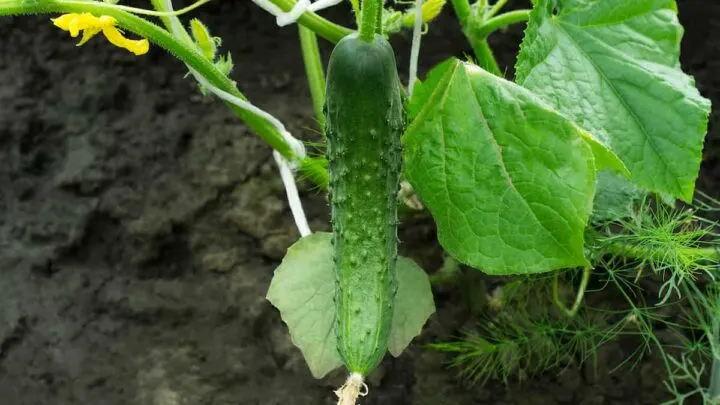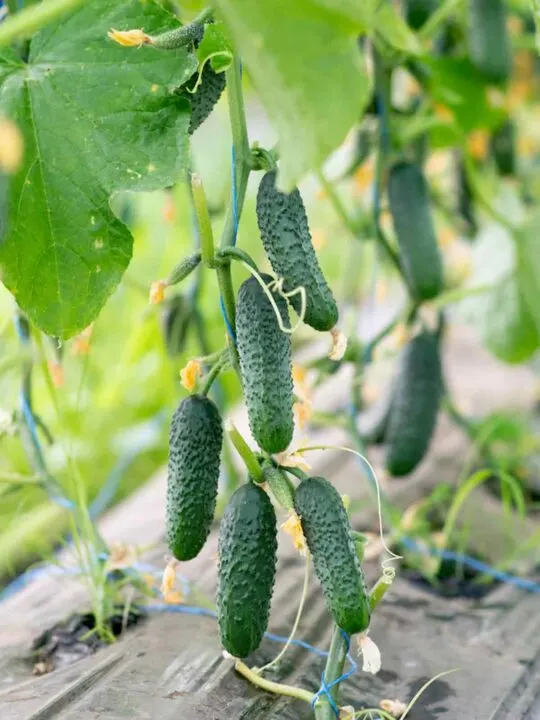Plants or fruits taking on an appearance that is out of the ordinary are a good reason for concern. An abnormally striped cucumber crop can lead you to wonder what is wrong or what’s causing the deviation in appearance. Why do my cucumbers have white lines?
Cucumbers with white or yellow lines or patches may have an incurable mosaic virus. This will also be apparent on leaves, though there are normal variations in coloration and stripes on the cucumbers depending on the difference in varietals.
Continue to learn more about the variations in cucumber appearance.

Why do my cucumbers have lines on them?
Lines on your cucumbers alone do not necessarily indicate disease or damage and can be chalked up to a different variety of cucumber that has been planted. If you notice that your fruits are also malformed or misshapen, and mosaic patterns appear on your plant’s leaves, then you’re likely dealing with cucumber mosaic virus.
Cucumber mosaic virus (CMV) is carried by pests and can be avoided by regularly checking your plants for pests. Controlling any weeds in your garden can also lessen the risk of infection since weeds can also attract pests, making the spread of the virus through your garden much easier and quicker.
Prevention is important when dealing with viruses since there is no cure, so pay attention to growing resistant varieties of plants, especially cucumbers and squash, which are commonly infected.
Other Causes
White lines on cucumbers can be scarring from insect feeding or physical damage from tendrils or other leaves rubbing against the cucumber.
Differences in cucumber varietals can also have some white streaking as a part of its normal appearance.
Pickling cucumbers have a more striped appearance and are bumpy, so seeing this is not a cause for alarm. Suppose your Burpless cucumbers, such as the English variety, have striping and an odd texture not typical of its type. In that case, it is reasonable to investigate further and determine what might be causing the distortions.

What is mosaic virus?
Mosaic virus is often transferred through aphids and is incurable. The virus alters your plant on a cellular level and can spread to the rest of the garden through the sap-sucking insects, so removing the affected plants is of utmost importance.
Symptoms of this virus include a mottled or “mosaic” pattern on the leaves, usually light green to yellow. Distorted fruits or lack of maturation of the fruits are also symptoms of a plant that is severely infected. Young plants that are infected may not make it to maturity and can collapse at the seedling stage.
If your plant is older and more mature when it gets infected, then you may not see many issues at all except for cosmetic ones, though it is still recommended to remove the plant as insects can still transfer the virus to healthy plants in the garden.
Once infected, the virus is systemic in the plant, moving through the cells into the plant’s sugar-conducting tissue, or phloem. In resistant varieties, the virus is kept in the cell and is not allowed to travel through the phloem, preventing the infection from affecting the whole plant.
However, some strains of CMV can overcome these barriers, making maintenance and prevention still relevant in the care of your cucumber plants.
Keep an eye out for aphids and treat all pests immediately and thoroughly. This will not only lower the chances of your plant contracting insect-borne diseases, but it will also keep your plant vigorous and productive. Use clean tools and sterilize them after use when handling your plants, infected or not. Practicing good hygiene in the garden is essential!

Common Problems in Cucumber Plants
Other factors can play into why your plant is displaying an abnormal appearance. Identifying the issue early on gives your plant a better chance of remaining healthy and productive throughout the season.
Malnutrition
Poor development, lack of flowering, and yellowing of leaves can be attributed to poor nutrition. The main three elements a plant needs for survival are nitrogen, phosphorus, and potassium, along with the “staples” of oxygen, carbon, and hydrogen, which are abundant in the environment. These macronutrients will determine how well your plant performs.
Giving your plant the nutrients it needs so it can thrive is vital to the plant’s longevity and production. Like people, plants need a continuous supply of energy and nutrition to be productive.
Regularly fertilizing fruiting crops during the growing season will keep your plants vigorous and better protected from pests and diseases than their malnourished counterparts.
Not all fertilizers are made equal, so ensure you’re giving your plant the correct balance it needs and in the correct dosage for optimal results. For cucumbers, a good ratio is 2-3-6 NPK.

Disease and Pests
Diseases or illnesses of plants can be attributed to bacteria, viruses, and fungal infections. Some can also be transmitted through pests. The best way to keep your plant free of diseases is by using clean tools when trimming and pruning, clearing debris and weeds, and keeping your plant healthy.
Unhealthy plants are more likely to be susceptible to not only diseases but pest infestation as well. Deterring pests can be done by keeping your plant clear of disease: maintaining good hygiene and carrying out weeding and pruning tasks will eliminate conditions essential to breeding many pests and diseases.
Lack of Fruit Production
Lack of fruiting is almost always due to insufficient pollination. You can add more plants to your garden to attract honeybees and bumblebees to naturally pollinate your plants, or you can take matters into your own hands by enlisting the help of a clean, soft paintbrush and a bit of time.
Locate the male flower (often shorter without a swollen base) and swab the inside to collect pollen to brush onto the female flower. After about a day, the flower should close up, indicating successful pollination.
Final Thoughts
Abnormal appearances are the simplest way to notice your plant is trying to tell you something. Treating your plant in the early stages of distress is often much easier than waiting to see if it goes away on its own and leads to fewer consequences down the line during the growing season.
Identification and swift action will go a long way, considering your crop’s health and overall yield. Stay observant and get to know your plants, as it can save you a lot of trouble in the future.

Hi there, my name is Allie and welcome to my blog; GareningWithAllie!
Much of what you see written here is just our personal experiences with gardening. Along with the content I write here, there is also a unique collection of gardening topics covered by some of our close friends. I hope you find everything you read here to be helpful, informative, and something that can make your gardening journey the most lovely experience ever! With that said, Happy Gardening!
